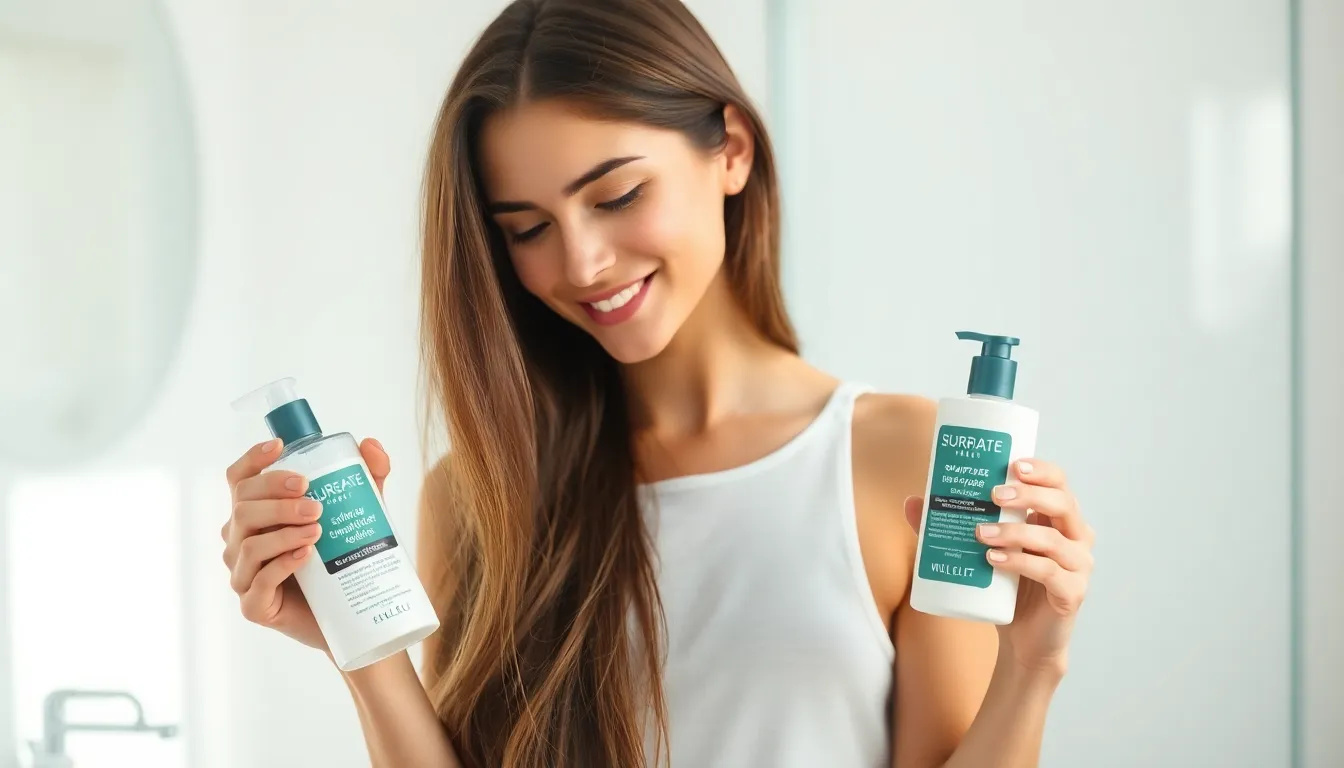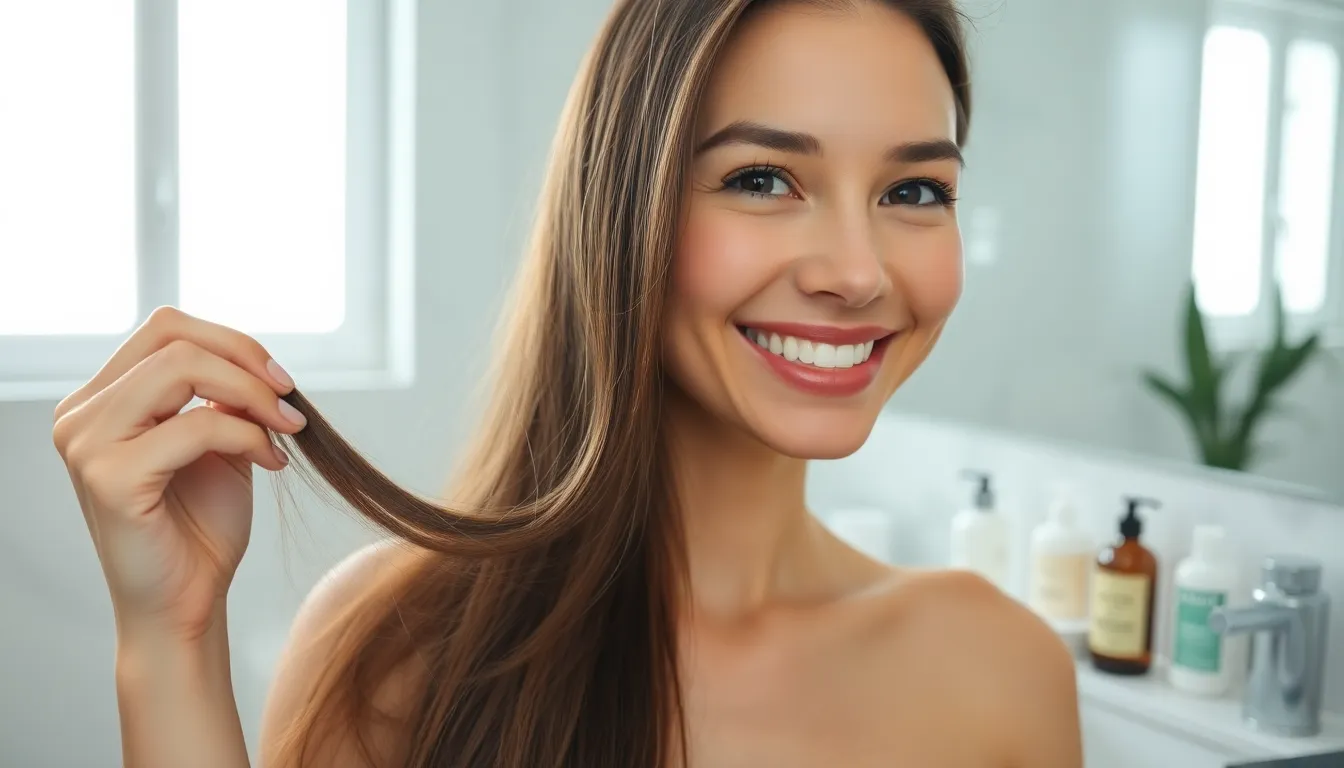We’ve all been there – staring at our reflection and wishing our hair would grow faster and thicker. Whether you’re dealing with hair loss, thinning strands, or simply want to achieve those long locks you’ve been dreaming about, understanding how to stimulate healthy hair growth can feel overwhelming with so much conflicting advice out there.
The truth is, growing strong and healthy hair isn’t just about expensive treatments or miracle products. It’s about understanding the science behind hair growth and implementing proven strategies that work with your body’s natural processes. From the foods you eat to the way you care for your scalp, every choice impacts your hair’s potential.
We’re here to cut through the noise and share evidence-based methods that actually deliver results. These aren’t quick fixes or empty promises – they’re practical techniques that address the root causes of slow or stunted hair growth and help you unlock your hair’s full potential.
Understanding the Hair Growth Cycle and What Affects It
We need to grasp the biological processes behind hair growth to carry out effective strategies that work with our body’s natural rhythms.
The Three Phases of Hair Growth
Anagen phase represents the active growth period when hair follicles produce new hair cells continuously. This phase typically lasts 2-7 years and determines the maximum length our hair can achieve. During anagen, hair grows approximately 0.5 inches per month, with scalp hair spending about 85-90% of its lifecycle in this productive stage.
Catagen phase marks the transitional period lasting 2-3 weeks when hair growth slows dramatically. Hair follicles shrink to about one-sixth of their normal length during this time. Only 1-3% of our hair experiences this phase simultaneously, preparing follicles for the final stage.
Telogen phase constitutes the resting period spanning 2-4 months before hair naturally sheds. Approximately 10-15% of our hair remains in this dormant state at any given time. New hair begins forming beneath the old strand, eventually pushing out the existing hair to restart the cycle.
Factors That Impact Hair Growth Rate
Nutritional deficiencies significantly slow hair production when our bodies lack essential vitamins and minerals. Iron deficiency affects up to 25% of women globally and can reduce hair growth by 30-50%. Protein intake below 0.8 grams per kilogram of body weight limits keratin synthesis, the primary building block of hair strands.
Hormonal fluctuations directly influence follicle activity through androgens like DHT (dihydrotestosterone). Elevated DHT levels can shrink follicles by up to 40%, particularly affecting the crown and hairline areas. Thyroid imbalances, stress hormones like cortisol, and reproductive hormone changes during pregnancy or menopause also alter growth patterns.
Environmental stressors create oxidative damage that disrupts normal follicle function. UV radiation, pollution, and harsh chemicals strip protective oils and weaken hair structure. Studies show that air pollution can reduce hair density by 15-20% in urban environments compared to rural areas.
Genetic Influences on Hair Growth Patterns
DNA determines our baseline growth rate through inherited follicle sensitivity and hormone production patterns. Research indicates that genetics account for approximately 80% of hair loss patterns, with exact genes like AR (androgen receptor) and variations in the EDAR gene affecting thickness and texture.
Ethnic background influences growth characteristics with important variations across populations. Asian hair typically grows 0.6 inches per month with the thickest diameter, while African hair grows 0.4 inches monthly but has a more fragile structure due to its curved follicle shape.
Family history predicts potential growth challenges including pattern baldness, premature graying, and maximum achievable length. Male pattern baldness affects 50% of men by age 50, while female pattern hair loss impacts 40% of women over 40, following predictable genetic inheritance patterns from both maternal and paternal lines.
Nourishing Your Body From Within for Optimal Hair Growth

We’ve explored the science behind hair growth cycles and external factors that influence follicle function. Now we’ll focus on the nutritional foundation that supports strong, healthy hair from the inside out.
Essential Vitamins and Minerals for Hair Health
Iron serves as the cornerstone mineral for robust hair growth, supporting oxygen transport to follicles and preventing the telogen effluvium that affects up to 30% of women with iron deficiency. We recommend consuming lean red meat, spinach, and lentils to maintain optimal iron levels between 15-18 mg daily for women and 8 mg for men.
Vitamin D3 activates hair follicle stem cells and promotes the anagen growth phase we discussed earlier. Research shows that 85% of people with alopecia have vitamin D deficiency below 30 ng/mL. Fatty fish like salmon, fortified dairy products, and moderate sun exposure help maintain adequate levels.
Biotin deficiency manifests in brittle hair and increased breakage, though true deficiency occurs in less than 0.1% of the population. We find that biotin supplements benefit those with genetic biotinidase deficiency or chronic antibiotic use that depletes gut bacteria producing this B vitamin.
Zinc regulates hormone levels and supports protein synthesis essential for keratin production in hair shafts. Oysters provide the highest zinc concentration at 74 mg per serving, while pumpkin seeds and chickpeas offer plant based alternatives for the recommended 8-11 mg daily intake.
Protein-Rich Foods That Promote Hair Growth
Complete proteins containing all nine essential amino acids form the building blocks of keratin, which comprises 95% of hair structure. We emphasize that hair follicles require consistent amino acid availability since they rank among the body’s most metabolically active tissues.
Eggs deliver the gold standard protein profile with a biological value of 100, meaning our bodies use nearly all amino acids efficiently. Two large eggs provide 12 grams of complete protein plus sulfur containing cysteine that strengthens disulfide bonds in hair strands.
Lean poultry and fish supply high quality protein while delivering additional hair supporting nutrients like selenium and omega 3 fatty acids. We recommend 0.8 grams of protein per kilogram of body weight daily, though active individuals may require up to 1.2 grams per kilogram.
Plant based protein combinations maximize amino acid profiles for vegetarians and vegans concerned about hair health. Quinoa stands alone as a complete plant protein, while combining legumes with grains creates complementary amino acid patterns that support keratin synthesis.
Hydration and Its Role in Hair Development
Adequate water intake maintains scalp circulation and ensures nutrient delivery to hair follicles through the dermal papilla blood supply we mentioned in the growth cycle discussion. Dehydration reduces blood flow by up to 20%, directly impacting follicle function and growth rates.
Cellular hydration affects hair shaft flexibility and strength, preventing the brittleness that leads to breakage and apparent growth stagnation. We observe that properly hydrated hair contains 10-13% water content, creating the elasticity needed for healthy manipulation and styling.
Daily fluid requirements vary based on activity level and climate, but we recommend starting with 8-10 glasses of water daily as a baseline. Coffee and tea contribute to fluid intake while providing antioxidants that may protect follicles from oxidative stress damage.
Electrolyte balance supports optimal hydration more effectively than water alone. Adding a pinch of sea salt or consuming coconut water helps maintain the sodium potassium balance necessary for efficient cellular fluid transport to hair producing tissues.
Creating an Effective Hair Care Routine for Growth

Building a consistent hair care routine forms the foundation for achieving optimal growth results. Strategic product selection and proper washing techniques work together to create the ideal environment for healthy follicle function.
Choosing the Right Shampoo and Conditioner
Sulfate-free formulas protect your hair’s natural protective barrier while gently cleansing away buildup that can clog follicles. We recommend looking for shampoos containing ketoconazole, which studies show reduces DHT levels on the scalp by up to 95%. Ingredients like biotin, caffeine, and niacinamide stimulate circulation while strengthening the hair shaft.
pH-balanced conditioners between 4.5 and 5.5 maintain optimal scalp health by preserving the acid mantle that protects against bacterial growth. Look for formulas enriched with ceramides and amino acids that repair damaged cuticles. Protein-rich conditioners containing hydrolyzed keratin can increase hair strength by 30% when used consistently over 8 weeks.
Avoid products containing harsh detergents like sodium lauryl sulfate that strip essential oils from your scalp. These chemicals disrupt the natural moisture balance and can lead to increased breakage. Instead, opt for gentle cleansing agents derived from coconut or sugar that maintain hydration levels.
How Often to Wash Your Hair for Maximum Growth
Fine hair types benefit from daily or every-other-day washing to prevent oil buildup that weighs down strands and clogs follicles. Excess sebum production can create an environment that inhibits healthy growth patterns. Light, volumizing formulas work best for these hair textures.
Medium to thick hair thrives with washing 2-3 times per week to maintain natural oil distribution throughout the hair shaft. This frequency allows beneficial sebum to nourish and protect strands while preventing excessive dryness. Over-washing can trigger increased oil production as the scalp tries to compensate.
Curly and coily hair requires washing only 1-2 times per week due to its structure that prevents oils from traveling down the hair shaft easily. These textures need more time between washes to maintain moisture levels. Co-washing with conditioner between shampoo sessions helps maintain hydration.
| Hair Type | Washing Frequency | Primary Concern |
|---|---|---|
| Fine | Daily to every 2 days | Oil buildup |
| Medium/Thick | 2-3 times per week | Balance maintenance |
| Curly/Coily | 1-2 times per week | Moisture retention |
The Importance of Deep Conditioning Treatments
Weekly deep conditioning treatments penetrate the hair shaft to repair damage from environmental stressors and styling tools. These intensive formulas contain smaller molecules that can reach the cortex layer where structural proteins reside. Consistent use can reduce breakage by up to 50% over 12 weeks.
Protein treatments should be alternated with moisturizing masks to prevent protein overload that can make hair brittle. Use protein-based treatments every 2-3 weeks for damaged hair, or monthly for healthy strands. Signs of protein overload include stiffness, dryness, and increased breakage.
Heat application during deep conditioning increases product effectiveness by opening the hair cuticle for better ingredient penetration. Apply treatments to damp hair and use a processing cap or warm towel for 15-20 minutes. Steam treatments can increase moisture absorption by 40% compared to room temperature applications.
Natural ingredients like avocado, honey, and coconut oil provide intense hydration while delivering essential fatty acids that strengthen the hair structure. These treatments work particularly well for chemically processed or heat-damaged hair that needs extra nourishment to maintain growth momentum.
Mastering Scalp Care to Stimulate Hair Follicles

Building on proper nutrition and hair care routines, we must address the foundation where hair growth begins: your scalp. Optimizing scalp health directly impacts follicle function and blood circulation to maximize growth potential.
Daily Scalp Massage Techniques
Effective scalp massage increases blood flow to hair follicles by up to 69% according to dermatological studies. We recommend performing these techniques for 5-10 minutes daily using gentle circular motions with your fingertips. Start at your temples and work systematically across your entire scalp, applying moderate pressure without causing discomfort.
Benefits multiply when we incorporate exact massage patterns that target different scalp regions:
- Frontal massage – Begin at your hairline and move fingers in small circles toward the crown
- Temporal massage – Focus on the sides above your ears using upward strokes
- Occipital massage – Work from the base of your skull upward using firm pressure
- Crown massage – Use both hands to create overlapping circular motions at the top of your head
Tools enhance massage effectiveness when used properly. We suggest using a scalp massager brush with soft silicone bristles or a jade roller designed for scalp use. These instruments distribute pressure evenly and reduce strain on your fingers during longer sessions.
Exfoliating Your Scalp for Better Growth
Regular scalp exfoliation removes dead skin cells that can block hair follicles and inhibit growth. We recommend exfoliating 1-2 times weekly using gentle scrubs or chemical exfoliants specifically formulated for scalp use. Physical exfoliation should never involve harsh scrubbing that can damage delicate follicle openings.
Chemical exfoliants provide superior results compared to physical scrubs in clinical trials:
| Exfoliant Type | Frequency | Benefits |
|---|---|---|
| Salicylic acid (0.5-2%) | 1-2x weekly | Dissolves buildup, reduces inflammation |
| Glycolic acid (5-10%) | 1x weekly | Removes dead cells, improves circulation |
| Tea tree oil (2-5%) | 2-3x weekly | Antimicrobial, reduces dandruff |
DIY exfoliating treatments work effectively when made with kitchen ingredients. We mix brown sugar with coconut oil for a gentle physical scrub, or combine apple cider vinegar with water for a mild chemical exfoliant. These homemade options cost significantly less than commercial products while delivering comparable results.
Using Essential Oils for Scalp Health
Essential oils penetrate the scalp barrier and provide therapeutic compounds directly to hair follicles. We dilute essential oils in carrier oils like jojoba, argan, or sweet almond oil before application to prevent irritation. A 2-3% dilution ratio works effectively for most people, which equals about 12-18 drops of essential oil per ounce of carrier oil.
Research supports exact essential oils for promoting hair growth and scalp health:
- Rosemary oil – Studies show it’s as effective as 2% minoxidil for increasing hair count
- Peppermint oil – Increases follicle depth and hair thickness by stimulating circulation
- Lavender oil – Promotes cellular regeneration and has antimicrobial properties
- Cedarwood oil – Balances sebum production and strengthens hair follicles
- Thyme oil – Improves circulation and has antifungal properties for scalp health
Application methods maximize essential oil benefits when we follow proper techniques. We apply oil blends to damp hair before shampooing, massage thoroughly into the scalp, and leave for 30-60 minutes before washing. Overnight treatments provide deeper penetration but require protective pillowcases to prevent staining.
Protecting Your Hair From Damage and Breakage

Damage and breakage remain the biggest obstacles to achieving healthy hair growth. We’ve established the foundation with proper nutrition and scalp care, but protecting your existing hair strands is equally crucial for maintaining length.
Heat Styling Best Practices and Alternatives
Temperature control makes the difference between healthy styling and severe damage. We recommend keeping heat tools below 300°F for fine hair, 350°F for medium hair, and 400°F maximum for coarse hair. Ceramic and tourmaline plates distribute heat more evenly than traditional metal tools, reducing hot spots that cause breakage.
Apply heat protectant products before every styling session. Look for formulas containing silicones like dimethicone or cyclomethicone, which create a protective barrier on hair shafts. Spray or distribute the product from mid-length to ends, avoiding roots to prevent weighing down your hair.
Air drying alternatives can dramatically reduce heat exposure. Wrap damp hair in microfiber towels instead of terry cloth to minimize friction and frizz. Try plopping curly hair with a cotton t-shirt to enhance natural curl patterns without heat. Braiding slightly damp hair creates gentle waves, while twist-outs work particularly well for textured hair types.
Limit heat styling to 2-3 times per week maximum. Schedule heat-free days between styling sessions to allow hair cuticles to recover and retain moisture. Consider overnight styling methods like foam rollers, silk scrunchies for loose buns, or protective braiding techniques.
Choosing Protective Hairstyles That Promote Growth
Low manipulation styles reduce daily handling that leads to breakage. Loose braids, low buns, and gentle ponytails keep hair secure without excessive tension. We avoid tight styles that pull at hairlines and edges, as these areas are most vulnerable to traction alopecia.
Silk and satin materials protect hair during sleep and styling. Replace cotton pillowcases with silk alternatives to reduce friction that causes tangles and breakage. Silk scrunchies and headbands also minimize hair damage compared to elastic bands with metal components.
Protective braiding techniques shield hair ends from environmental damage. French braids, Dutch braids, and loose fishtail braids keep hair contained while maintaining healthy tension levels. Change braid patterns every few days to prevent stress on the same sections of hair.
Natural texture embracing styles require less manipulation. Work with your hair’s natural growth patterns rather than fighting against them. Twist-outs, bantu knots, and wash-and-go styles celebrate natural textures while minimizing daily styling damage.
The Right Way to Brush and Detangle Hair
Start detangling from the bottom and work upward to prevent excessive pulling. We begin at hair ends and gradually move toward roots, removing knots in small sections. This method reduces the force required and prevents hair from snapping under pressure.
Wet hair requires extra gentle handling due to increased fragility. Use wide-tooth combs or detangling brushes specifically designed for wet hair. Apply leave-in conditioner or detangling spray to create slip and reduce friction between strands.
Brush selection impacts hair health significantly. Boar bristle brushes distribute natural oils from scalp to ends, while paddle brushes work well for straight to wavy textures. Denman brushes help define curls, and wet brushes feature flexible bristles that bend with hair movement.
Frequency depends on your hair type and styling routine. Fine hair benefits from daily brushing to prevent oil buildup, while curly and coily hair should only be detangled when wet with conditioner. Over-brushing disrupts natural curl patterns and increases frizz in textured hair types.
Incorporating Natural Remedies and DIY Treatments

Natural ingredients offer powerful alternatives to expensive commercial products while providing essential nutrients directly to your hair follicles. These time tested methods can significantly enhance your hair growth journey when combined with proper nutrition and scalp care practices.
Homemade Hair Masks for Growth Stimulation
Egg yolk masks provide concentrated protein and biotin that strengthen hair shafts and promote new growth. Mix 2 egg yolks with 2 tablespoons of olive oil and 1 tablespoon of honey for a weekly treatment that nourishes follicles for 20-30 minutes.
Avocado masks deliver essential fatty acids and vitamins A, D, and E that penetrate the hair shaft deeply. Mash 1 ripe avocado with 2 tablespoons of coconut oil and apply from roots to tips for enhanced moisture retention and reduced breakage.
Banana masks offer potassium, natural oils, and vitamins that improve hair elasticity and shine. Blend 2 ripe bananas with 1 tablespoon of almond oil and 1 teaspoon of vitamin E oil for a monthly intensive treatment that repairs damaged cuticles.
Greek yogurt masks contain lactic acid that gently removes buildup while providing protein to strengthen weak hair strands. Combine 1/2 cup plain Greek yogurt with 1 tablespoon of raw honey and massage into damp hair for 15-20 minutes before shampooing.
Herbal Rinses and Their Benefits
Rosemary rinses stimulate blood circulation in the scalp and contain compounds that may block DHT production naturally. Steep 2 tablespoons of dried rosemary in 2 cups of boiling water for 30 minutes, strain, and use as a final rinse after shampooing.
Green tea rinses provide antioxidants and caffeine that energize hair follicles and reduce inflammation. Brew 2 green tea bags in 2 cups of hot water, cool completely, and pour over clean hair while massaging the scalp gently.
Apple cider vinegar rinses balance scalp pH and remove product buildup that can clog follicles and slow growth. Mix 2 tablespoons of raw apple cider vinegar with 1 cup of water and use monthly to clarify the scalp and enhance shine.
Nettle leaf rinses contain silica, sulfur, and potassium that strengthen hair structure and reduce excessive shedding. Boil 1/4 cup of dried nettle leaves in 2 cups of water for 15 minutes, strain when cool, and apply to towel dried hair.
Time Tested Natural Ingredients for Hair Growth
Castor oil contains ricinoleic acid that increases circulation and has antimicrobial properties beneficial for scalp health. Apply 2-3 drops to fingertips and massage into exact areas of concern 2-3 times per week before bedtime.
Fenugreek seeds provide lecithin and protein that strengthen hair follicles and add natural shine to strands. Soak 2 tablespoons of seeds overnight, grind into paste, and apply to scalp for 30 minutes before washing out thoroughly.
Aloe vera gel soothes irritated scalps while providing enzymes that remove dead skin cells blocking follicles. Extract fresh gel from aloe leaves and massage into clean scalp 3 times per week for optimal follicle health.
Onion juice contains sulfur compounds that boost collagen production and improve blood circulation to hair roots. Blend 1 medium onion, strain the juice, and apply to scalp for 15 minutes before shampooing to minimize the strong scent.
Coconut milk provides lauric acid and essential proteins that penetrate hair shafts and reduce protein loss during washing. Extract milk from 1 fresh coconut, warm slightly, and apply as a pre shampoo treatment for 45 minutes weekly.
Making Lifestyle Changes That Support Hair Growth

Beyond topical treatments and nutrition, certain lifestyle modifications can dramatically influence our hair’s ability to grow thick and strong. These foundational changes address the root causes of hair growth disruption at a cellular level.
Managing Stress for Better Hair Health
Chronic stress elevates cortisol levels by up to 300%, which directly disrupts the hair growth cycle by pushing follicles into the telogen phase prematurely. We can combat this by incorporating daily stress reduction techniques that lower cortisol production.
Meditation reduces cortisol levels by 23% within just 8 weeks of consistent practice. Start with 10 minutes daily using apps like Headspace or Calm to establish a routine. Progressive muscle relaxation techniques help release physical tension that restricts blood flow to the scalp.
Deep breathing exercises activate the parasympathetic nervous system within 2-3 minutes. Practice the 4-7-8 technique: inhale for 4 counts, hold for 7, exhale for 8. Repeat this cycle 4 times whenever stress levels spike throughout the day.
Regular journaling decreases anxiety levels by 15-20% according to clinical studies. Spend 5-10 minutes each evening writing about daily experiences and emotions. This practice helps process stress before it accumulates and affects our hair follicles.
Yoga combines movement with mindfulness to reduce stress hormones by 27%. Focus on gentle poses like child’s pose, cat-cow stretches, and legs-up-the-wall pose. These positions increase circulation to the head while promoting relaxation.
Exercise and Its Impact on Hair Growth
Physical activity increases blood circulation by 40-60%, delivering essential nutrients and oxygen directly to hair follicles. We should aim for 150 minutes of moderate exercise weekly to optimize hair growth conditions.
Cardiovascular exercise boosts scalp circulation more effectively than any other activity. Running, cycling, swimming, or brisk walking for 30 minutes increases blood flow for up to 2 hours post-workout. This enhanced circulation carries growth-promoting nutrients to follicle cells.
Strength training elevates growth hormone levels by 200-400% during and after workouts. Focus on compound movements like squats, deadlifts, and push-ups that engage multiple muscle groups. Growth hormone stimulates protein synthesis essential for keratin production.
Inverted yoga poses increase scalp blood flow by 300% compared to upright positions. Incorporate downward dog, headstands, or legs-up-the-wall pose into daily routines. Hold these positions for 3-5 minutes to maximize circulation benefits.
High-intensity interval training (HIIT) reduces DHT levels by 25% through improved hormone regulation. Alternate between 30 seconds of intense activity and 90 seconds of recovery for 15-20 minutes. This exercise pattern optimizes hormonal balance for hair growth.
Getting Quality Sleep for Optimal Hair Development
Hair follicles regenerate and produce new cells primarily during deep sleep phases, making quality rest crucial for growth. We need 7-9 hours of uninterrupted sleep to support optimal hair development cycles.
Growth hormone peaks during deep sleep, increasing by 600% between 10 PM and 2 AM. Maintain consistent bedtimes within this window to maximize natural growth hormone production. This hormone directly stimulates hair follicle cell division and protein synthesis.
Sleep deprivation reduces hair growth rates by 25-30% within just one week of poor rest. Establish a sleep hygiene routine that includes avoiding screens 2 hours before bed and keeping bedrooms cool (65-68°F). Blue light exposure suppresses melatonin production and disrupts growth cycles.
REM sleep stages activate cellular repair mechanisms in hair follicles. Create optimal sleep conditions with blackout curtains, white noise machines, and comfortable pillows. These environmental factors ensure deeper, more restorative sleep phases.
Silk pillowcases reduce hair friction by 43% compared to cotton materials. Switch to silk or satin pillowcases to prevent mechanical damage during sleep movements. This simple change minimizes breakage and allows existing hair to reach its full length potential.
Scalp massage before bed increases melatonin production while stimulating follicles. Spend 5-10 minutes massaging the scalp with gentle circular motions using fingertips. This practice combines relaxation benefits with direct follicle stimulation for enhanced overnight growth.
Avoiding Common Mistakes That Hinder Hair Growth

Many of us unknowingly sabotage our hair growth efforts through daily habits and styling choices. Recognizing these common pitfalls allows us to make adjustments that support healthier, stronger hair development.
Over-Processing and Chemical Damage
Chemical treatments create important barriers to healthy hair growth by weakening the hair shaft and disrupting follicle function. Frequent coloring, perming, relaxing, or bleaching strips away the hair’s protective cuticle layer, leading to increased breakage and slower growth rates.
Timing chemical services correctly prevents excessive damage to growing hair. We recommend spacing color treatments at least 6-8 weeks apart and waiting 12-14 weeks between chemical straightening or perming sessions. Professional colorists suggest limiting bleaching to once every 3-4 months to allow hair recovery time.
Overlapping chemicals amplifies damage exponentially rather than additively. Applying relaxers over previously colored hair or bleaching recently permed sections can cause severe breakage or complete hair loss. Professional stylists emphasize performing strand tests before combining any chemical processes.
Recovery protocols become essential after chemical damage occurs. Deep protein treatments should be alternated with moisturizing masks every 2-3 weeks to rebuild damaged hair bonds. Trimming chemically processed ends every 6-8 weeks removes damaged sections that could continue breaking up the hair shaft.
Tight Hairstyles and Tension-Related Hair Loss
Constant tension from tight hairstyles creates traction alopecia, a form of hair loss that can become permanent if left unchecked. Braids, ponytails, buns, and extensions that pull on the hairline and scalp gradually weaken hair follicles and reduce their ability to produce healthy strands.
Rotating hairstyles prevents concentrated stress on exact scalp areas. We should alternate between loose styles, protective updos, and completely down hairstyles throughout the week. Hair elastics without metal clasps and silk scrunchies reduce friction and pulling.
Warning signs of traction alopecia include scalp tenderness, small bumps around hair follicles, and thinning along the hairline or crown. Early intervention through gentler styling practices can reverse these symptoms within 3-6 months of consistent care.
Protective styling requires proper technique to avoid counterproductive tension. Braids should feel comfortable when first installed, as hair naturally tightens as it settles. Extension weight shouldn’t exceed 20% of your natural hair weight to prevent follicle stress.
Professional installation ensures extensions and protective styles support rather than hinder growth. Licensed stylists can assess individual hair density and recommend appropriate tension levels for different hair textures and growth goals.
Neglecting Regular Trims and Split End Prevention
Split ends travel up the hair shaft like runs in stockings, creating progressively more damage that eventually requires cutting away length gains. Microscopic splits become visible fractures within 4-6 weeks without intervention, potentially destroying months of growth progress.
Trimming schedules should align with individual hair growth rates and damage patterns. Fine hair typically requires trims every 6-8 weeks, while thicker, coarser hair can extend to 10-12 weeks between cuts. Chemically processed or heat-damaged hair benefits from more frequent maintenance every 4-6 weeks.
Prevention strategies eliminate split ends before they form and travel. Leave-in conditioners with silicones create protective barriers against environmental damage. Sleeping on silk pillowcases reduces friction that can cause splits during nighttime movement.
Professional assessment identifies damage that home inspection might miss. Licensed stylists use specialized tools to detect microscopic splits and recommend targeted treatments. Regular professional trims using sharp shears create clean cuts that seal the hair cuticle and prevent future splitting.
Search and destroy methods allow length retention while addressing isolated damage. Using hair cutting shears, we can trim individual split ends without sacrificing overall length. This technique works best on straight to wavy hair textures where splits are easily visible.
When to Seek Professional Help for Hair Growth Issues

While we’ve covered many strategies for promoting healthy hair growth, some situations require professional intervention to address underlying medical conditions or accelerate results.
Identifying Signs of Hair Loss or Thinning
Excessive daily hair shedding serves as the first warning sign that professional help may be necessary. We should be concerned if we’re losing more than 100-150 hairs per day consistently for several weeks. Sudden increases in hair fall during washing, brushing, or simply running fingers through hair indicate potential issues that merit professional evaluation.
Visible scalp patches represent another clear indicator for seeking medical attention. Areas where the scalp becomes noticeable through thinning hair, particularly around the crown or hairline, suggest pattern hair loss or alopecia. These changes often develop gradually over months, making early detection crucial for effective treatment.
Textural changes in hair quality can signal underlying health problems affecting hair growth. Hair that becomes suddenly brittle, loses its natural shine, or changes color without chemical treatments may indicate nutritional deficiencies or hormonal imbalances. We should also watch for changes in growth rate, as hair that stops growing or breaks at the same length repeatedly needs professional assessment.
Family history patterns combined with personal changes warrant medical consultation. If we notice thinning patterns similar to parents or grandparents, especially when accompanied by other symptoms like fatigue or weight changes, professional evaluation can provide early intervention options.
Medical Treatments and Professional Options
Prescription medications offer the most clinically proven results for pattern hair loss and medical conditions affecting growth. Finasteride blocks DHT production in men, while minoxidil increases blood flow to follicles for both men and women. These treatments require medical supervision and can take 3-6 months to show visible improvements.
Platelet-rich plasma (PRP) therapy utilizes concentrated growth factors from our own blood to stimulate dormant follicles. Medical professionals extract and process blood samples, then inject the plasma into affected scalp areas. Studies show 30-40% improvement in hair density after 3-4 treatment sessions spaced monthly.
Hair transplant procedures provide permanent answers for important hair loss cases. Follicular unit extraction (FUE) and follicular unit transplantation (FUT) move healthy follicles from donor areas to thinning regions. Modern techniques achieve natural-looking results with minimal scarring when performed by experienced surgeons.
Laser therapy treatments deliver exact wavelengths of light to stimulate cellular activity in hair follicles. Low-level laser therapy (LLLT) increases ATP production and improves blood circulation at the follicle level. Professional-grade devices provide stronger outputs than home units, typically requiring 20-30 minute sessions twice weekly.
Hormone replacement therapy addresses hair loss caused by hormonal imbalances, particularly in women experiencing menopause or thyroid disorders. Balanced hormone levels can restore normal hair growth cycles and prevent further thinning when administered under medical supervision.
Working With a Trichologist or Dermatologist
Comprehensive scalp analysis forms the foundation of professional hair loss treatment. Trichologists use specialized equipment like dermoscopy and trichoscopy to examine follicle health, measure hair density, and identify inflammation or infections. This detailed assessment guides personalized treatment plans targeting exact causes of hair loss.
Customized treatment protocols combine multiple approaches based on individual diagnosis and hair loss patterns. Professionals may recommend combining topical treatments, oral supplements, and in-office procedures to maximize results. Regular monitoring allows for treatment adjustments based on progress and response rates.
Advanced diagnostic testing can uncover underlying medical conditions affecting hair growth that we might miss with home remedies. Blood tests for iron levels, thyroid function, hormone balance, and autoimmune markers provide crucial information for targeted treatments. Early detection of conditions like alopecia areata or androgenetic alopecia enables more effective interventions.
Professional product recommendations ensure we’re using clinically tested ingredients at proper concentrations. Dermatologists can prescribe stronger formulations than over-the-counter options and recommend exact brands with proven efficacy. They also help avoid harmful ingredients or combinations that could worsen hair loss.
Long-term monitoring and maintenance help sustain hair growth improvements over time. Regular follow-up appointments track progress, adjust treatments as needed, and catch new issues early. Professional guidance ensures we maintain results while adapting care routines as our hair and scalp needs change with age or hormonal shifts.
Conclusion
We’ve equipped you with comprehensive strategies to transform your hair growth journey from frustrating to fulfilling. By combining proper nutrition scalp care and protective techniques you’re now ready to unlock your hair’s true potential.
Remember that sustainable hair growth isn’t about quick fixes—it’s about consistency and patience. The methods we’ve outlined work together synergistically so don’t expect overnight miracles but trust the process.
Your hair growth success depends on implementing these evidence-based approaches while listening to your body’s unique needs. Whether you choose natural remedies professional treatments or a combination of both you now have the tools to achieve the strong healthy hair you’ve always wanted.
Start with the fundamentals we’ve discussed and gradually build your personalized routine. Your future self will thank you for taking action today.
Frequently Asked Questions
What are the three phases of the hair growth cycle?
The hair growth cycle consists of three distinct phases: the anagen phase (active growth lasting 2-7 years where hair actively grows), the catagen phase (a transitional period of 2-3 weeks where growth stops), and the telogen phase (a resting period of 2-4 months before hair sheds). Understanding these phases helps you optimize your hair care routine for maximum growth potential.
Which vitamins and minerals are essential for healthy hair growth?
Key nutrients for hair growth include iron for oxygen transport to follicles, vitamin D3 for activating hair follicle stem cells, biotin for preventing brittle hair, and zinc for hormone regulation. Protein is crucial for keratin production, while adequate hydration maintains scalp circulation and nutrient delivery to hair follicles.
How often should I wash my hair for optimal growth?
Washing frequency depends on your hair type. Fine hair benefits from daily washing, medium to thick hair should be washed 2-3 times per week, and curly or coily hair only needs washing 1-2 times weekly. Use sulfate-free shampoos to protect your hair’s natural barrier and maintain optimal scalp health.
What are the best natural ingredients for DIY hair treatments?
Effective natural ingredients include egg yolk for protein, avocado and banana for moisture, castor oil for growth stimulation, and aloe vera gel for scalp health. Herbal rinses like rosemary, green tea, and apple cider vinegar can improve scalp circulation and hair vitality when used regularly in your routine.
How does stress affect hair growth?
Chronic stress elevates cortisol levels, which can disrupt the hair growth cycle and push follicles into the resting phase prematurely. This leads to increased shedding and slower growth. Managing stress through meditation, deep breathing, yoga, and regular exercise helps maintain healthy hair growth patterns and follicle function.
When should I seek professional help for hair growth issues?
Consider professional consultation if you experience excessive daily shedding (more than 100 hairs), visible scalp patches, sudden changes in hair texture, or significantly slower growth rates. A trichologist or dermatologist can provide comprehensive scalp analysis and recommend medical treatments like minoxidil, PRP therapy, or hair transplant procedures.
What common mistakes hinder hair growth?
Major growth-hindering mistakes include over-processing with chemicals, wearing tight hairstyles that cause traction alopecia, skipping regular trims that prevent split ends, and using harsh heat styling without protection. Avoiding these mistakes and spacing chemical treatments appropriately helps maintain healthy hair shaft integrity and follicle function.
How important is scalp health for hair growth?
Scalp health is crucial for optimal hair growth as it directly affects follicle function and nutrient delivery. Daily scalp massages increase blood circulation, regular exfoliation removes dead skin cells that block follicles, and essential oils can stimulate growth. A healthy scalp creates the ideal environment for strong hair development.












